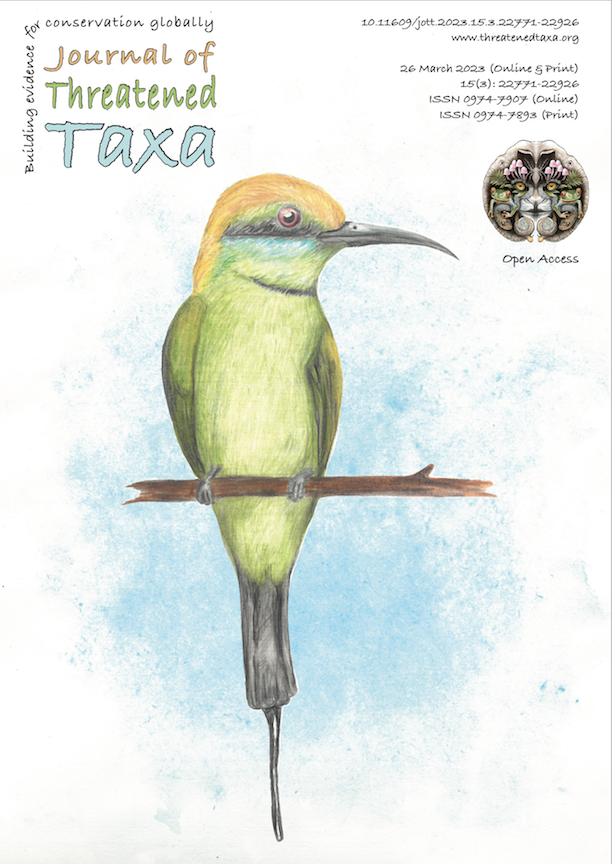Diversity of bees in two crops in an agroforestry ecosystem in Kangsabati South Forest Division, Purulia, West Bengal, India
Main Article Content
Abstract
The investigation study assesses the diversity of bees in Brinjal Solanum melongena L. and Ridge Gourd Luffa acutangula L. crop field from agroforestry ecosystem in South Kangsabati Forest Division, India. The study was carried out in May 2021 to May 2022 that based on transect, focal observation and pan trap samplings. A total of 1,085 individuals were identified during the field work, belonging to three family seven genera (Apis, Tetragonula, Xylocopa, Ceratina, Amegelia, Nomia, and Megachile) and seventeen species, the non Apis bees (63.78%) were most abundant than Apis bees (36.22%). In brinjal, Shannon diversity index of bees is 2.12 and Shannon evenness index is 0.35, whereas, Shannon diversity index in ridge gourd was 1.94 and Shannon evenness index is 0.3. The observations signify greater diversity and population of wild bees. The natural habitat close to agricultural land helps to sustain the diversity and population of wild bees, which enhance the crop quality and yield.
Article Details

This work is licensed under a Creative Commons Attribution 4.0 International License.
Authors own the copyright to the articles published in JoTT. This is indicated explicitly in each publication. The authors grant permission to the publisher Wildlife Information Liaison Development (WILD) Society to publish the article in the Journal of Threatened Taxa. The authors recognize WILD as the original publisher, and to sell hard copies of the Journal and article to any buyer. JoTT is registered under the Creative Commons Attribution 4.0 International License (CC BY), which allows authors to retain copyright ownership. Under this license the authors allow anyone to download, cite, use the data, modify, reprint, copy and distribute provided the authors and source of publication are credited through appropriate citations (e.g., Son et al. (2016). Bats (Mammalia: Chiroptera) of the southeastern Truong Son Mountains, Quang Ngai Province, Vietnam. Journal of Threatened Taxa 8(7): 8953–8969. https://doi.org/10.11609/jott.2785.8.7.8953-8969). Users of the data do not require specific permission from the authors or the publisher.
References
Balachandran, C., M.D. Subash Chandran, S. Vinay, N. Shrikant & T.V. Ramachandra (2017). Pollinator diversity and foraging dynamics on monsoon crop of cucurbits in a traditional landscape of South Indian West coast. Biotropia 24(1): 16–27. https://doi.org/10.11598/btb.2017.24.1.480
Bingham, C.T. (1897). The Fauna of British India Including Ceylon and Burma, Hymenoptera,Vol. I. Wasps and Bees. Taylor and Francis, London, 564pp.
Buchmann, S.L. (1983). Buzz pollination in angiosperms. Van Nostrand Reinhold Company, New York, 63–113pp.
Gibson, R.H., B. Knott, T. Eberlein, & J. Memmott (2011). Sampling method influences the structure of plant-pollinator. Oikos 120: 822–831. https://doi.org/10.1111/j.1600-0706.2010.18927.x
Greenleaf, S.S. & C. Kremen (2006). Wild bees enhance honey bees’ pollination of hybrid sunflower. Proceedings of the National Academy of Sciences 103(37): 13890–13895. https://doi.org/10.1073/pnas.0600929103
Hagen, M. & M. Kraemer (2010). Agricultural surroundings support flower visitor networks in an Afrotropical rain forest. Biological Conservation 143(7): 1654–63. https://doi.org/10.1016/j.biocon.2010.03.036
Herren, B.M. & A.O. Ochieng (2008). Role of native bees and natural habitats in eggplant (Solanum melongena) pollination in Kenya. Agriculture, Ecosystems & Environment 127(1–2): 31-36. https://doi.org/10.1016/j.agee.2008.02.002
Javorek, S.K., K.E. Mackenzie & S.P.V. Kloet (2002). Comparative pollination effectiveness among bees (Hymenoptera: Apoidea) at lowbush blueberry (Ericacea: Vaccinium angustifolium). Annals of the Entomological Society of America 95(3): 345–351. https://doi.org/10.1603/0013-8746(2002)095[0345:CPEABH]2.0.CO;2
Kay, S., E. Kuhn, M. Albrecht, L. Sutter, E. Szerencsits & F. Hezrog (2019). Agroforestry can enhance foraging and nesting resources for pollinators with focus on solitary bees at the landscape scale. Agroforestry Systems 94: 379-387. https://doi.org/10.1007/s10457-019-00400-9
Kremen, C., N.M. Williams & R.W. Thorp (2002). Crop pollination from native bees at risk from agricultural intensification. Proceedings of the National Academy of Sciences 99(26): 16812–16816. https://doi.org/10.1073/pnas.262413599
Michener, C. D. (1979). Biogeography of the Bees. Annals of the Missouri Botanical Gardens 61(3): 277–347. https://doi.org/10.2307/2398833
Michener, C.D., R.J. McGinley & B.N. Danforth (1994). The Bee Genera of North and Central America (Hymenoptera: Apoidea). Archives of Natural History. Smithsonian Institution Press, Washington, 209pp.
Michener, C. D. (2007). The Bees of The World. The Johns Hopkins University Press, Baltimore, 1016 pp.
Patricio, G.B., B.B. Grisolia, I.C. Desuo, P.C. Montagnana, E.G. Gomig & M.J.O. Campos (2012). The Importance of Bees for Eggplant Cultivations (Hymenoptera: Apidae, Andrenidae, Halictidae). Sociobiology 59(3): 1037–1052.
Silva. P.N., M. Hrncir, C.I. Silva, Y.S. Roldao & V.L. Imperatriaz-Fonseca (2013). Stingless bees, Melipona fasciculata, as efficient pollinators of eggplant (Solanum melongena)in greenhouses. Apidologie 44: 537–546. https://doi.org/10.1007/s13592-013-0204-y
Sinu, P.A. & K.R. Shivanna (2007). Pollination ecology of cardamom (Elettaria cardamomum) in the Western Ghats, India. Journal of Tropical Ecology 23(4): 493–496. https://doi.org/10.1017/S0266467407004191
Harterreiten-Souza, E.S., P.H.B. Togni, C.S.S. Pires & E.R. Sujii (2014). The role of integrating agroforestry and vegetable planting in structuring communities of herbivorous insects and their natural enemies in the Neotropical region. Agroforestry Systems 8(8): 205–219. https://doi.org/10.1007/s10457-013-9666-1
Stamps, W.T. & M.J. Linit (1998). Plant diversity and arthropod communities: Implications for temperate agroforestry. Agroforestry Systems 39: 73–89.
Sutherland, W.J. (2006). Ecological census techniques: A handbook. 2nd Edition. Cambridge University Press. UK. 145-146pp.
Sutter, L., F. Herzog, V. Dietemann, J.D. Charriere & M. Albrecht (2017). Demand, supply and value of insect pollinator for the Swiss agriculture production. Recherche Agronomique Suisse 9: 332–339.
Westphal, C., R. Bommarco, G. Carre, E. Lamborn, N. Morison, T. Petanidou, S.M. Potts, S.P.M. Roberts, H. Szentgyorgyi, T. Tscheulin, B.E. Vaissiere, M. Woyciechowski, J.C. Biesmeijer, W.E. Kunin, J. Settele & I. Steffan-Dewenter (2008). Measuring bee diversity in different European habitats and biogeographical regions. Ecological Monographs 78 (4): 653–671.
Winfree, R. (2010). The conservation and restoration of wild bees. Annals of the New York Academy of Science 1195: 169-197. https://doi.org/10.1111/j.1749-6632.2010.05449.x

